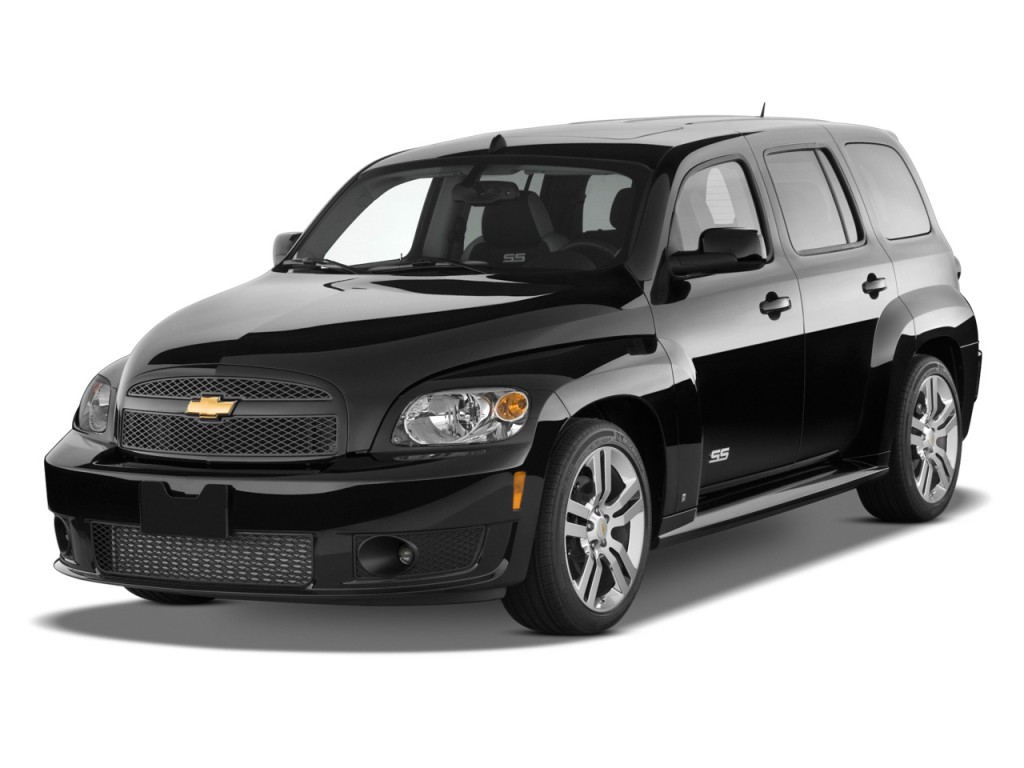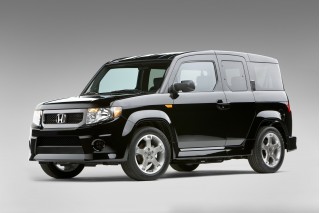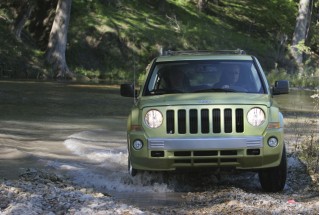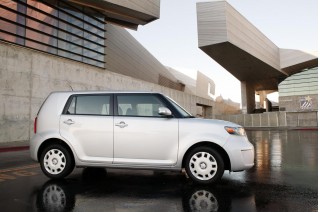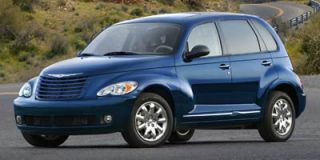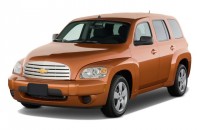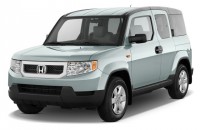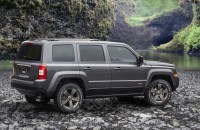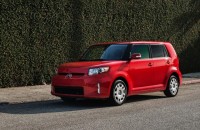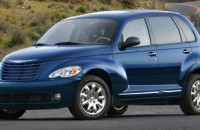Likes
- Versatile, cargo-friendly layout
- Ride comfort
Dislikes
- Transmission only has four speeds
- Tight headroom
- Gauges too small
- Placement of power window controls
Buying tip
features & specs
The 2010 Chevrolet HHR has love-it-or-hate-it styling, but it should appeal to those who want good cargo capability in an economical ride.
The Chevy HHR is a tall-roofed crossover, sharing some common architecture with the Chevrolet Cobalt. Overall, it's a well-orchestrated machine that provides practical cargo space and decent performance. Its basic architecture is similar to that of the Chevrolet Cobalt, with a lineup of four-cylinder engines providing reasonably fuel-efficient operation.
From the outside there's not much else on the road that can match the HHR on styling. The 2010 Chevrolet HHR has a design heritage harking back half a century, thus the name HHR, which stands for Heritage High Roof. The interior is much more "normal" and carlike, with the exception of a slightly higher seating position. Once again, the vehicle is available in two different body styles: a traditional four-door, five-passenger wagon and a two-seat Panel van. The HHR Panel van is geared toward small-business use, with windowless rear cargo panel doors and windowless rear quarter panels, along with cargo-floor storage compartments and a rear 40-amp power point for electronic equipment.
The basic 2010 Chevrolet HHRs are offered with the choice of one of two different four-cylinder engines: a 2.2-liter unit or 2.4-liter mill. A standard five-speed manual transmission or optional four-speed automatic comes with either engine on this front-wheel-drive vehicle. Additionally, a remote start feature is offered with the 2.4-liter. Last year variable valve timing was added to the base 2.2-liter mill, and this saw output increase to 155 horsepower, up from 149 horses the previous year. Fuel economy was also improved, yielding a driving range of up to 500 miles between service station stops with this more efficient engine. It should be noted that regardless of the transmission, performance isn't anything to shout about, though it's still decent for this class.
The 2010 Chevrolet HHR SS is an impressive offering that targets performance enthusiasts. Powering the SS is a turbocharged and direct-injected 2.0-liter four-cylinder engine, which enables the HHR SS to achieve EPA-rated highway mileage of 29 mpg with the manual transmission and 28 mpg with the automatic. Driver-selectable performance features including the “no-lift shift” help the SS achieve 0-60 mph performance in 6.3 seconds and cover the quarter-mile in 14.8 seconds at 98.5 mph. Equipped with the manual transmission, the SS has a top speed of more than 150 mph. Non-SS versions of the 2010 HHR have a very soft suspension, and it's not very nimble for tight corners or quick maneuvers, but the HHR LT and SS models include a sport-tuned suspension that doesn't sacrifice too much ride quality. The electric power steering in the HHR is a disappointment; it's just too light and imprecise in standard versions, though the revised tuning in the SS is an improvement.
Although the 2010 Chevrolet HHR has a versatile, roomy cargo space that can accommodate a lot of groceries or small pieces of furniture, the HHR is only fair for passengers. Headroom is rather tight, and the front seats provide a pushed-upward driving position that some drivers might like but others will consider odd. Interior appointments aren't anything special; there's a lot of drab plastic trim, and upholstery and materials are rental-car anonymous. On the bright side, the HHR feels tight and refined most of the time, with surprisingly little road or wind noise.
When it comes to safety, the HHR hardly impresses either. Federal crash-test results are five-star for frontal and side impact, but the insurance-supported IIHS rates the HHR just "acceptable" for side impact and a concerning "marginal" in the seat-based rear-impact test. Standard safety equipment for the 2010 Chevy HHR includes anti-lock front disc/rear drum brakes on LS and LT models, as well as anti-lock four-wheel discs on the SS. Stability control and side curtain airbags are standard as well, though front seat side-impact airbags aren't offered. GM's OnStar telematics system is also standard across the HHR model lineup.
Chevrolet has decided not to muck with the successful formula, with the only changes for 2010 consisting of an optional rearview camera and the elimination of the sporty SS trim for the HHR Panel body style. Standard features include air conditioning, an AM/FM/MP3/CD sound system with auxiliary input jack and satellite radio, power windows/locks/mirrors, remote keyless entry, cruise control, 16-inch wheel covers, a trip computer, and the aforementioned OnStar system.
2010 Chevrolet HHR Styling
With styling that's retro-throwback on the outside, a bit bland on the inside, designers are clearly at odds over the balance of function over form in the 2010 Chevrolet HHR.
From the outside, there's not much else on the road that can match the HHR on styling. The 2010 Chevrolet HHR has a design heritage harking back half a century, thus the name HHR, which stands for Heritage High Roof.
Edmunds considers the Chevrolet HHR, which Chevrolet has said was inspired by the 1949 Suburban, "a modern take on the expressive, big-fendered American vehicles of the late 1940s.”
Across the board, the styling on the 2010 Chevy HHR garners a mixed reception from reviewers. Car and Driver is a fan of its “pleasing exterior curves,” as is the Detroit News, which likes the “playful retro design inside and out.” On the other hand, the Detroit News points out that the HHR “looks like such a blatant copy” of the Chrysler PT Cruiser.
A special HHR SS version, which—most notably from a styling standpoint—has larger wheels and flashier rims that give it a different sense of proportion, first appeared in 2008. It receives some sweet design cues to highlight the vehicle's high-performance drivetrain. Autoblog says there are "some changes with the Chevrolet HHR SS, but the car is still instantly recognizable as a Heritage High Roof." Cars.com comments "the [Chevrolet] HHR SS is a stylish one from many angles... helping its cause are a number of SS-specific cues, like a black mesh grille that replaces the horizontal silver bars on regular Chevrolet HHRs."
The HHR Panel van is geared toward small-business use, with windowless rear cargo panel doors and windowless rear quarter panels, along with cargo-floor storage compartments and a rear 40-amp power point for electronic equipment.
Sadly, the retro theme doesn't translate that strongly in the interior, the styling of which appears similar to the rest of the GM range. The interior is much more "normal" and carlike, with the exception of a slightly higher seating position. Automobile Magazine positively reports on the “nice, suede-like inserts on the seats." Kelley Blue Book claims that "the Chevrolet HHR features thoroughly modern interior styling...tasteful chrome rings and accents combine with pleasing buttons and knobs" and Edmunds makes a note of the “handsome bright-ringed gauges" and calls the interior “attractive and functional.”
2010 Chevrolet HHR Performance
The standard trims of the 2010 Chevrolet HHR are adequate unless you need a little more excitement. For that, you have the SS version.
The basic 2010 Chevrolet HHRs are offered with the choice of one of two different four-cylinder engines: a 2.2-liter unit or 2.4-liter mill. A standard five-speed manual transmission or optional four-speed automatic comes with either engine on this front-wheel-drive vehicle. Additionally, a remote start feature is offered with the 2.4-liter. Last year variable valve timing was added to the base 2.2-liter mill, and this saw output increase to 155 horsepower, up from 149 horses the previous year. Fuel economy was also improved, yielding a driving range of up to 500 miles between service station stops with this more efficient engine. It should be noted that regardless of the transmission, performance isn't anything to shout about, though it's still decent for this class.
The general consensus across the board is that both of these engines aren't going to win any awards for passing or acceleration, though they remain spirited and economical. Edmunds finds the 2.4-liter engine “a worthwhile upgrade.” ConsumerGuide, on the other hand, reports that "2.4-liter models have decent around-town go, but highway passing and hill climbs can feel labored," adding that the "automatic transmission is responsive [and] quick to downshift." Reviewers agree that the performance is neither nippy nor smooth. The Detroit News remarks that “the Chevy's powertrain was unable to inspire much confidence, especially during merging and passing,” and Edmunds refers to the “lack of low-end pull and refinement from the 2.4-liter engine.”
While most of the HHR's rivals are also front-wheel drive only, Edmunds finds fault with the fact that the HHR lacks an AWD option “for enhanced foul-weather capability.”
The 2010 Chevrolet HHR SS is an impressive offering that targets performance enthusiasts. Powering the SS is a turbocharged and direct-injected 2.0-liter four-cylinder engine, which enables the HHR SS to achieve EPA-rated highway mileage of 29 mpg with the manual transmission and 28 mpg with the automatic. Driver-selectable performance features, including the “no-lift shift,” help the SS achieve 0-60 mph performance in 6.3 seconds and cover the quarter-mile in 14.8 seconds at 98.5 mph. Equipped with the manual transmission, the SS has a top speed of more than 150 mph. Non-SS versions of the 2010 HHR have a very soft suspension, and it's not very nimble for tight corners or quick maneuvers, but the HHR LT and SS models include a sport-tuned suspension that doesn't sacrifice too much ride quality. The electric power steering in the HHR is a disappointment; it's just too light and imprecise in standard versions, though the revised tuning in the SS is an improvement.
Edmunds claims this version offers “spirited performance.” Its turbocharged 2.0-liter Ecotec four-cylinder makes 260 horsepower that is channeled to the front wheels through a five-speed manual transmission. Autoblog points out that the HHR SS "packs an impressive 130 horsepower per liter," and Cars.com is happy that the turbo engine “pulls the HHR SS with satisfying strength."
Autoblog states that in the SS "the automatic loses out on power by a few dozen horses and offers a more sedate driving experience," while also recommending that you "stick to the manual so you don't miss out on the awesomeness that is the launch control and no-lift shifting." The SS gets a slicker manual gearbox, though; ConsumerGuide finds it "has smooth shift and clutch action, unlike other manual HHRs, which suffer from long throws and crude movement."
In terms of fuel economy, the 2010 Chevrolet HHR can be best described as frugal. Autoblog suggests that one should "hold off the throttle pedal a bit and you'll be able to get near 30 mpg on the highway." EPA estimates range up to 30 mpg highway with the 2.2-liter engine and manual transmission. ConsumerGuide points out that "Chevrolet recommends premium-grade gas for SS and 2.4-liter models, regular otherwise."
If you're expecting any sort of performance, the SS is the only trim that should be considered. Car and Driver notes that the HHR has “rubbery steering, bobby suspension, and imprecise control,” though it notes a “smooth ride.” ConsumerGuide states that the Chevrolet HHR is "composed overall, though the ride can get bouncy over sharp bumps," and Edmunds recommends that "it's best to maintain an easygoing pace, as the suspension and steering just can't keep up with overly aggressive driving... the electric-assisted steering is slow to respond and numb in feel, [and] the HHR exhibits a loss of straight-line stability during maximum braking." The SS version is a different beast entirely: When it comes to handling, it has “stronger braking and buttoned-down handling,” Edmunds explains.
2010 Chevrolet HHR Comfort & Quality
The HHR is not the car for you if luxury, comfort, or refinement is a priority.
Although the 2010 Chevrolet HHR has a versatile, roomy cargo space that can accommodate a lot of groceries or small pieces of furniture, the HHR is only fair for passengers. Headroom is rather tight, and the front seats provide a pushed-upward driving position that some drivers might like but others will find odd.
Reviewers across the board highlight the lack of passenger comfort the Chevrolet HHR affords. Edmunds finds that the Chevrolet HHR's "standard cloth buckets are not as comfortable as we'd like, but the optional leather seats are better cushioned and more supportive," while the editors from Cars.com expresses the "wish [that] the HHR had a telescoping steering column so [one] could pull the wheel closer," adding "backseat comfort is only marginal...bench seat's bottom and backrest cushions are hard and the space is legroom-challenged." Car and Driver, on the other hand, is a fan of the “sofa-like rear seat.”
The 2010 Chevrolet HHR really excels when it comes to storage space and cargo, however. Edmunds claims that "maximum cargo capacity is among the class leaders at 63 cubic feet," and Cars.com states that "considering its small exterior size, the HHR SS can swallow quite a bit of cargo." ConsumerGuide praises the vehicle's "versatile storage space," remarking, "it's easy to fold the 60/40 split rear seat backs to create a flat load floor, but front seat backs must be far forward for headrests to clear.” It should be noted that this can leave little legroom in front for tall drivers.
Interior appointments aren't anything special; there's a lot of drab plastic trim, and upholstery and materials are rental-car anonymous. On the bright side, the HHR feels tight and refined most of the time, with surprisingly little road or wind noise.
The HHR, while not winning any awards for interior quality, covers the basics. According to Cars.com, "most surfaces are textured enough to where they don't look especially cheap. SS models have slightly sportier trim that neither enhances nor detracts from the overall ambiance." Edmunds, however, notes that "window buttons are awkwardly mounted behind the shifter, and some of the interior plastics are of mediocre quality."
In terms of driving refinement, the 2010 Chevrolet HHR isn't anything to crow about. According to ConsumerGuide, "wind rush is well controlled, but engine buzz intrudes during acceleration. The turbo four-cylinder whines, even under light throttle conditions. All [Chevrolet HHR] models suffer from noticeable coarse-surface tire thrum."
2010 Chevrolet HHR Safety
Visibility can be an issue in the 2010 Chevrolet HHR, and it has mid-pack crash-test scores altogether.
When it comes to safety, the HHR hardly impresses. Federal crash-test results are five-star for frontal and side impact, but the insurance-supported IIHS rates the HHR just "acceptable" for side impact and a concerning "marginal" in the seat-based rear-impact test.
Standard safety equipment for the 2010 Chevy HHR includes anti-lock front disc/rear drum brakes on LS and LT models, as well as anti-lock four-wheel discs on the SS. Stability control and side curtain airbags are also standard, though front seat side-impact airbags aren't offered. GM's OnStar telematics system is standard across the HHR model lineup as well.
Opinions among reviewers on outward visibility are split. Edmunds applauds the "impressive outward visibility for the regular wagon models," whereas Cars.com finds "something HHR drivers battle that isn't an issue in many other cars is forward visibility. This wagon's unique shape results in a relatively short windshield, which in turn leads to wide windshield pillars—that get in the way when checking for cross traffic or pedestrians." It also points out that "rear- and over-shoulder visibility is good."
The panel-wagon version, which was intended as a work vehicle, has bad rear visibility due to the omission of certain windows.
2010 Chevrolet HHR Features
The 2010 Chevrolet HHR offers a competitive list of options to keep most buyers happy.
Chevrolet has decided not to muck with the successful formula, with the only changes for 2010 consisting of an optional rearview camera and the elimination of the sporty SS trim for the HHR Panel body style.
Standard features include air conditioning, an AM/FM/MP3/CD sound system with auxiliary input jack and satellite radio, power windows/locks/mirrors, remote keyless entry, cruise control, 16-inch wheel covers, a trip computer, and the aforementioned OnStar system.
ConsumerGuide reports that the vehicle's "features availability are competitive" in this segment and price range.
Kelley Blue Book states that one of their favorite features is the "front-mounted auxiliary input jack [that] makes it easy to connect any MP3 player or other audio source to the HHR's sound system." Optional extras include “leather seating, heated front seats, power driver's seat, stiffer suspension, power moonroof, 260-watt sound system with subwoofer, in-dash six-disc changer, MP3 compatibility [and] XM Satellite Radio," they say.
Edmunds points out that "major options for the LT include remote vehicle starting (included with the 2010 Chevrolet HHR automatic transmission), leather seating with heated front seats, in-dash CD changer, satellite radio and a sunroof."
